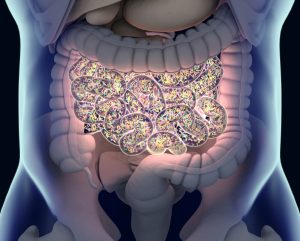Why Is Your Microbiome Important?
Author: Dr. Stephen Chaney
 We have known for years that primarily plant-based diets are healthy. As I have shared in my book, “Slaying The Food Myths”, people who consume primarily plant-based diets have lower risk of heart disease, diabetes, and some cancers and live longer than people who consume the typical American diet.
We have known for years that primarily plant-based diets are healthy. As I have shared in my book, “Slaying The Food Myths”, people who consume primarily plant-based diets have lower risk of heart disease, diabetes, and some cancers and live longer than people who consume the typical American diet.
But why is that?
- Is it the nutrients, phytonutrients, and fiber plant foods provide?
- Is it because plant foods are lower in saturated fats and are good sources of healthier monounsaturated and polyunsaturated fats?
- Or is it because plant foods have a low caloric density, which makes it easier to maintain a healthy weight?
The answer, of course, is that all the above are important. But is there something else? Is there a “missing link” we don’t talk about much? Many experts think our microbiome (our gut bacteria) is that missing link.
You have heard the saying, “We are what we eat”. You might be scratching your head and saying, “I could eat cabbages all day long, but I am never going to become a cabbage.” It seems like a crazy saying.
But for our microbiome that saying is true. What we call fiber, our gut bacteria call food. Consequently,  vegetarians and meat eaters have very different populations of gut bacteria in their microbiome. The question, of course, is whether these differences influence our health. This central question has spurred multiple research studies on our microbiome in recent years.
vegetarians and meat eaters have very different populations of gut bacteria in their microbiome. The question, of course, is whether these differences influence our health. This central question has spurred multiple research studies on our microbiome in recent years.
Two central themes have emerged from these studies:
- There are certain populations of gut bacteria that are associated with healthy outcomes (lower risk of obesity, diabetes, heart disease, and some cancers). We can think of these as “good bacteria”.
-
- There are certain populations of gut bacteria that are associated with unhealthy outcomes (increased risk of obesity, diabetes, heart disease, and some cancers). We can think of these as “bad bacteria”.
- People consuming primarily plant-based diets tend to have more of the “good bacteria” and less of the “bad bacteria” in their gut microbiome.
However, most of these studies have been small and have looked at individual foods rather than the effect of the overall diet.
The study (KK Koponen et al, American Journal Of Clinical Nutrition, 2021; doi.org/10.1093/ajcn/nqab077 I will describe today was designed to overcome those limitations.
Metabolism 101: What Are Short Chain Fatty Acids And Why Are They Important?
 To fully understand the findings of this study, you need to understand what short chain fatty acids are and why they are important. Simply put, short chain fatty acids are the end products of fiber digestion by some species of gut bacteria in our intestines. The major short chain fatty acids in our intestines are acetate (2 carbons), propionate (3 carbons), and butyrate (4 carbons).
To fully understand the findings of this study, you need to understand what short chain fatty acids are and why they are important. Simply put, short chain fatty acids are the end products of fiber digestion by some species of gut bacteria in our intestines. The major short chain fatty acids in our intestines are acetate (2 carbons), propionate (3 carbons), and butyrate (4 carbons).
There are the key facts about short chain fatty acids you should know:
- They are formed by anaerobic fermentation of dietary fiber by our gut bacteria. However:
-
- Not all gut bacteria can produce short chain fatty acids.
-
- The amount and type(s) of dietary fiber determine whether the gut bacteria that can produce short chain fatty acids are present.
2) Acetate is readily absorbed into the bloodstream and is utilized for fat production and other biosynthetic pathways.
3) Short chain fatty acids, especially butyrate, are the primary energy source for cells lining the colon. Because of this, they have several important health benefits.
-
- They support the immune cells that line our intestine. This helps strengthen our immune system.
-
- They help maintain the integrity of the intestinal wall. This helps protect against leaky gut syndrome.
-
- They reduce inflammation. This reduces the risk of inflammatory bowel diseases like ulcerative colitis and Crohn’s disease.
-
- They reduce the risk of colon cancer.
4) In addition, small amounts of propionate and butyrate can be absorbed into the bloodstream. Butyrate is of particular interest because it has the potential to regulate gene expression.
-
- There is some evidence that short chain fatty acid production in the intestine is correlated with reduced risk of inflammatory diseases, obesity, type 2 diabetes, and heart disease, but these studies remain controversial.
How Was This Study Done?
 This study made use of data from the FINRISK Study. This study was conducted by the Finnish Institute of Health and Welfare every 5 years between 1972 and 2012 to assess risk factors for noncommunicable diseases, health behavior, and their changes in adult Finns.
This study made use of data from the FINRISK Study. This study was conducted by the Finnish Institute of Health and Welfare every 5 years between 1972 and 2012 to assess risk factors for noncommunicable diseases, health behavior, and their changes in adult Finns.
This study included 4930 individuals from the 2002 FINRISK assessment. The characteristics of the group were:
- 53% female, 47% male.
- Average age = 48.
- Average BMI = 26.9 (slightly overweight).
Upon entry into the study, the participants were asked to fill out a food frequency questionnaire.
- The data from this questionnaire were used to calculate a Healthy Food Choices (HFC) score based on the Nordic Nutrition Dietary Guidelines for a healthy diet.
-
- The HFC score ranged from 9-745 and was based on the consumption of fiber-rich breads; vegetables (including beans and lentils); fruits; berries; fresh, non- sweetened berry and fruit juices; fish; poultry; low-fat cheeses; salad dressings and oils; nuts; and seeds.
-
- In the words of the authors, “A high HFC score effectively acts as an indicator of a healthy omnivorous Nordic diet rich in plants, fiber, and polyunsaturated fatty acids.”
- The data were also used to calculate a total dietary fiber score.
The participants were also asked to provide a stool sample. DNA was extracted from the stool sample and sequenced to determine the number and types of bacteria in their gut microbiome. These data were analyzed for:
- Bacterial diversity (greater bacterial diversity is associated with better health outcomes).
- Species of gut bacteria known to be associated with better health outcomes.
- Species of bacteria known to produce short chain fatty acids.
How Diet And Gut Bacteria Affect Our Health
 Microbiome research is complex. But here is a description of the results in simple terms.
Microbiome research is complex. But here is a description of the results in simple terms.
Both the Healthy Food Choice (HFC) and fiber scores correlated positively with:
- Bacterial diversity (greater bacterial diversity is associated with better health outcomes).
- Species of gut bacteria known to be associated with better health outcomes.
- Species of bacteria known to produce short chain fatty acids that are associated with better health outcomes.
Simply put, a healthy, primarily plant-based Nordic diet produces the kind of gut microbiome that is associated with better health outcomes.
When the authors analyzed the contribution of individual components of the diet to a healthy microbiome:
- Vegetables; berries; fruits; fiber-rich breads; salad dressings and oils; low-fat cheeses; poultry; fresh, unsweetened juices; and fish were all positively associated with a healthy microbiome.
-
- Each of these foods supported the growth of different gut bacteria that contributed to the healthy microbiome.
-
- Simply put, none of these foods was sufficient by itself. It was a healthy diet with all these foods that resulted in a healthy microbiome.
- Nuts and seeds did not affect the microbiome. This may have been because there was too little of them in the diet to have a significant effect.
- Red and processed meats were negatively associated with a healthy microbiome.
The authors concluded, “Our results from a large, population-based survey confirm and extend the findings of other, smaller-scale studies that plant- and fiber-rich dietary choices are associated with a more diverse and compositionally distinct microbiome with a greater potential to produce short chain fatty acids.”
The authors also said, “The associated between red and processed meat products and the gut microbiome cannot be ignored either…[Our data] indicate that increased usage of red and processed meat is associated with the microbiome composition in an opposite manner to that of a healthy diet.”
Why Is Your Microbiome Important?
 The most important message from this and previous studies is that your gut microbiome is the “missing link” between a healthy diet and a healthy body.
The most important message from this and previous studies is that your gut microbiome is the “missing link” between a healthy diet and a healthy body.
Simply put, healthy diet →→→healthy microbiome→→→healthy body
However, I also need to acknowledge microbiome research is in its infancy. That is because our microbiome is very complex:
- We have around 38 trillion microorganisms (give or take a few trillion) in our intestine. That means we have slightly more microorganisms than we do cells in our body.
- Each of us have more than 1,000 different species of bacteria in our intestine.
- Collectively, these bacteria have around 750,000 genes. That is 30 times more than the number of genes in our DNA.
- Finally, we all have different species of bacteria in our intestines. We are all unique.
The only simplifying principle is that these bacteria exist in communities that generally group together. Unraveling the complexities and identifying the communities of bacteria in our intestines requires high throughput DNA sequencing and supercomputers to analyze the data.
Studies like this one can identify the associations between diet and distinct communities of bacteria. They can even identify which foods in the diet support the growth of these bacterial communities. Other studies can identify the association between distinct communities of bacteria and healthy outcomes.
The strength of this study is that it identifies the kind of diet and the kinds of food that support the communities of bacteria associated with healthy outcomes. However, these are just associations. They don’t tell us why these associations occur. Specifically:
- We don’t know why certain diets are associated with different communities of gut bacteria. However, we do know several things.
-
- The diet should contain a variety of high fiber foods. This is because different kinds of fiber support the growth of different kinds of gut bacteria, and the diversity of our gut microbiome is associated with healthy outcomes. As I have said before, “We have 5 food groups for a reason”.
-
- However, the type of fat and the type of protein in the diet also influence the type of bacteria that thrive in our intestines. We know less about why that is.
- We also don’t know why certain communities of gut bacteria are associated with healthy outcomes.
-
- The exception is communities of bacteria that produce short chain fatty acids. We do have a good idea why short chain fatty acids are associated with gut health.
However, the fact we don’t know why these associations occur, doesn’t detract from the strength of these associations.
- The associations between a healthy, primarily plant-based diet and a healthy microbiome are not based on this study alone. The same associations have been seen in multiple studies.
- The associations between a healthy microbiome and better health outcomes have also been seen in multiple studies.
The evidence for these associations is too strong to ignore.
What Does This Study Mean For You?
 This study shows that a healthy Nordic diet is associated with a healthy microbiome. “But what is a healthy Nordic diet?”, you might ask. Simply put, it is a whole food, omnivorous, primarily plant-based diet with Scandinavian food preferences.
This study shows that a healthy Nordic diet is associated with a healthy microbiome. “But what is a healthy Nordic diet?”, you might ask. Simply put, it is a whole food, omnivorous, primarily plant-based diet with Scandinavian food preferences.
And, if pickled herring, potato pancakes, and meatballs aren’t your favorite foods, never fear. You have lots of other options:
- The Mediterranean diet is essentially the same diet with Mediterranean food preferences.
- The DASH diet is essentially the same diet with American food preferences.
- You can start with a semi-vegetarian diet and tailor it to your food preferences. Of course, some common sense is required here. You will need to primarily include whole, unprocessed food preferences in your diet.
Let me close with some simple advice I have shared before:
- We are what we eat. Our microbiome (gut bacteria) reflects what we eat.
- What we call fiber, our gut bacteria call food. A primarily plant-based diet is best because our friendly gut bacteria thrive on the fiber it provides.
- We have 5 food groups for a reason. Each plant food group provides different kinds of fiber and feeds different families of friendly gut bacteria. We eliminate plant food groups at our peril.
- We should think of red meat as a condiment, not a main course. Plants contain antidotes to many of the harmful ingredients in red meat. Two to three ounces of steak as part of a green salad or stir fry is much healthier than an 8-ounce steak and fries.
The Bottom Line
Most previous studies on the effect of diet on our microbiome have been small and have looked at individual foods rather than the effect of the overall diet. In this week’s “Health Tips From the Professor” I report on a large, well-designed study that examined the effect of a healthy Nordic diet on our microbiome.
In case you were wondering, the investigators defined a healthy Nordic diet as a whole food diet that:
- Includes lots of fruits, vegetables, and whole grains and is, therefore, high in fiber.
- Uses fish, poultry, and low-fat cheeses as its primary protein source.
- Minimizes red and processed meats.
- Has more polyunsaturated oils than saturated fats.
- Reflects Scandinavian food preferences.
This study found that a healthy Nordic diet correlated positively with:
- Bacterial diversity (greater bacterial diversity is associated with better health outcomes).
- Species of gut bacteria known to be associated with better health outcomes.
- Species of bacteria known to produce short chain fatty acids that are associated with better gut health outcomes.
Simply put, a healthy, primarily plant-based Nordic diet produces the kind of gut microbiome that is associated with better health outcomes. To put this into perspective, a healthy Nordic diet is similar to a healthy Mediterranean diet or a healthy DASH diet except that the Mediterranean diet reflects Mediterranean food preferences, and the Dash diet reflects American food preferences.
The most important message from this and previous studies is that your gut microbiome is the “missing link” between a healthy diet and a healthy body.
Simply put, healthy diet →→→healthy microbiome→→→healthy body
I summed up the article with some simple advice I have shared before:
- We are what we eat. Our microbiome (gut bacteria) reflects what we eat.
- What we call fiber, our gut bacteria call food. A primarily plant-based diet is best because our friendly gut bacteria thrive on the fiber it provides.
- We have 5 food groups for a reason. Each plant food group provides different kinds of fiber and feeds different families of friendly gut bacteria. We eliminate plant food groups at our peril.
- We should think of red meat as a condiment, not a main course. Plants contain antidotes to many of the harmful ingredients in red meat. Two to three ounces of steak as part of a green salad or stir fry is much healthier than an 8-ounce steak and fries.
For more details about this study and what it means for you, read the article above.
These statements have not been evaluated by the Food and Drug Administration. This information is not intended to diagnose, treat, cure, or prevent any disease.

